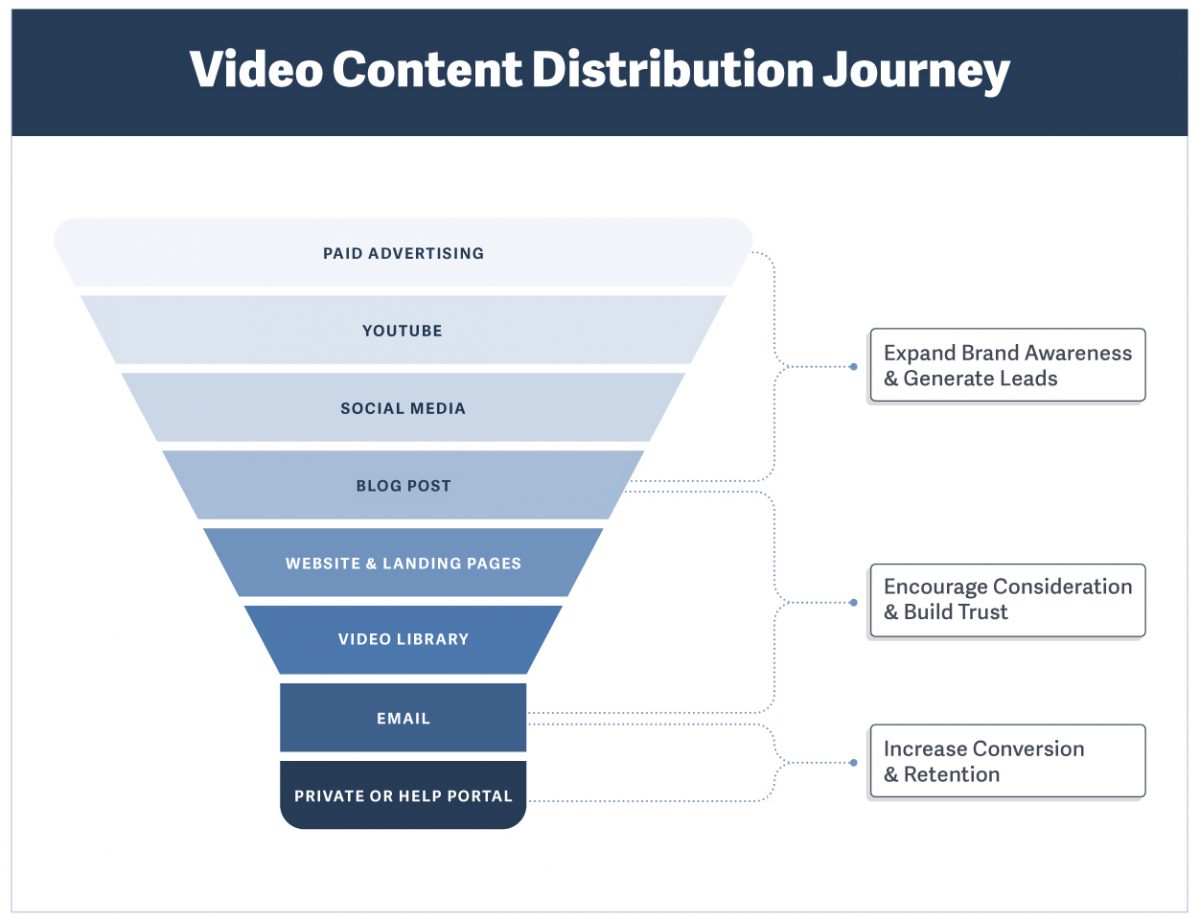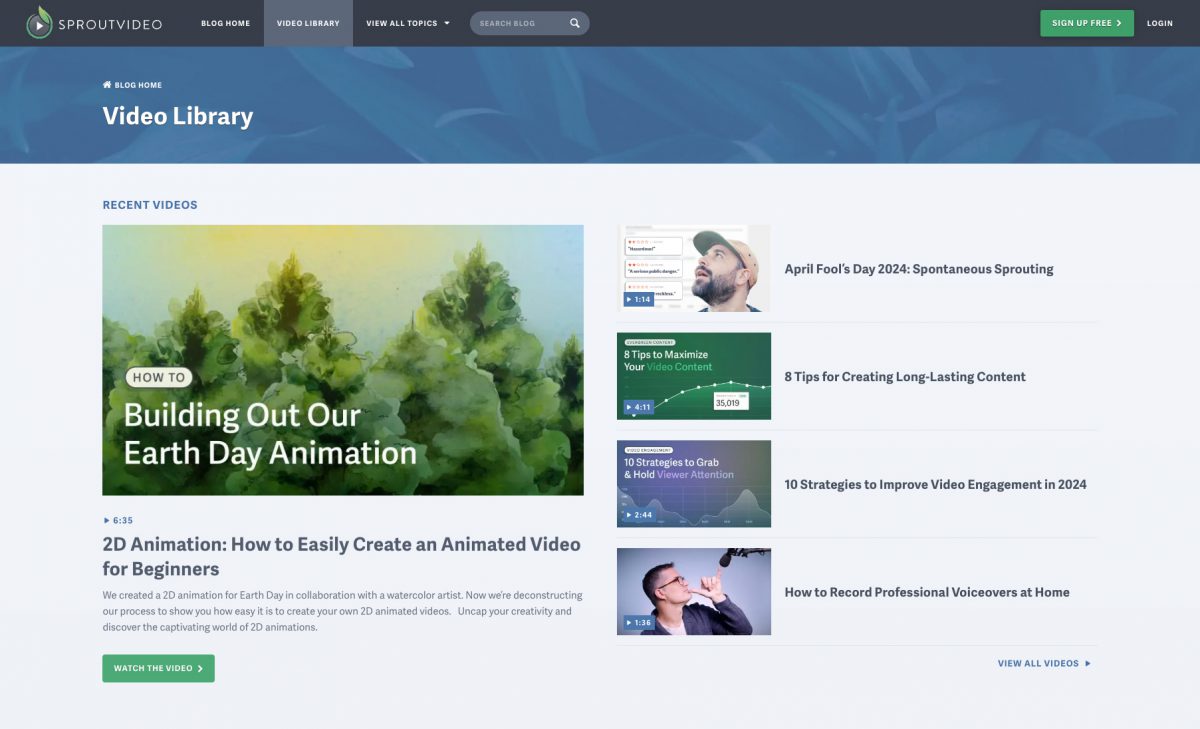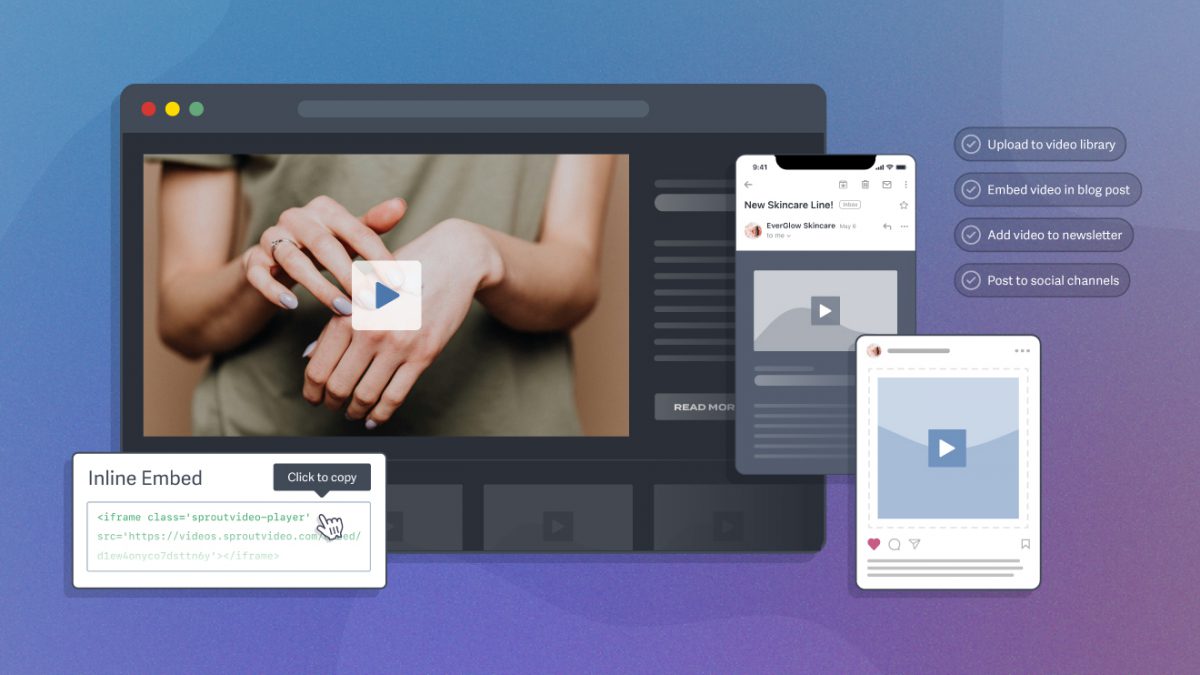Your audience is scattered across the internet.
Some users are on your email list, some follow one of your social media profiles, and others are looking for solutions using search or AI.
Yet video needs to engage your audience across marketing channels and stages of the buyer’s journey, regardless of the type of video content you create.
For good reason: 91% of people use video to learn more about products and services.
But how do you distribute video content to produce the results you want?
This guide answers that question with a video content distribution strategy to maximize the longevity and reach of your videos without expecting you to have unlimited resources.
You’ll learn how to effectively utilize social media for video, fuel organic discovery via search engines, and infuse video into your sales funnel to attract new (and engage current) customers.
The Challenge of Catering to Every Channel
Big and small companies produce videos to promote their brand, build relationships with a core audience, and generate leads. But how do you center those goals when creating videos?
One common practice is to share a single piece of content across various marketing channels. However, the challenge with this approach is that every channel has its own optimization standards.
Most companies and creators don’t have unlimited resources to create a video optimized for each channel or platform.
The alternative: Strategically optimize one to three versions of your video, catering to your highest-value channels or those with the most growth potential.
This approach allows you to optimize your video content for the channels that provide the greatest return on your investment while building a presence across relevant channels.
8 Video Content Distribution Channels That Work

Engage your audience across multiple channels with varied content — from product demos to educational videos — to effectively meet your audience at every stage of their journey.
We’ve organized the video content distribution channels below with the buyer’s journey in mind, starting at the top with awareness and closing with after-sale content for loyalty and retention.
Reach New Communities with Paid Advertising
Paid video advertising lets you break out of the algorithmic bubble social media often locks users into. You can target specific audiences based on demographics, user engagement with similar content, and other profile information (depending on the platform).
Many marketers run their video ads on advertising platforms like Google or Microsoft (see pro-tip below). Others may run their ads on streaming platforms like Hulu or Amazon.
There are also native video advertising networks like Taboola and Outbrain that support video formats. Finally, many marketers use social media platforms with video advertising, including YouTube, Instagram, Facebook, Pinterest, TikTok, Twitter, Reddit, LinkedIn, Spotify, and many more.
Align the platforms where you promote paid video advertising with your core purchasing audience.
Most social platforms allow you to promote previously published content, which is a great way to test how well your video converts before paying to promote it broadly.
Pro Tip: Video can also be part of your Google ad campaign. For example, when someone clicks on your Search ad, Google may retarget that person on YouTube with your video ad.
Google’s Performance Max campaigns allow advertisers to upload materials in various mediums. Google then compiles the ads and distributes them across its ad network, allowing your advertising to meet potential customers wherever they are online.
Expand Organic Discovery with YouTube
51% of all YouTube visitors want to learn how to do something.
For this reason, businesses use YouTube as a social channel to share thought leadership and educational content or showcase how real people use a product or service.
Furthermore, while video-based, YouTube is the second-largest search engine in the world — second only to Google itself, which also displays YouTube videos in its search results.
Therefore, sharing your video content on YouTube can support your approach to SEO by increasing the potential for discovery on the YouTube platform and within search results.
Note: The YouTube platform displays video recommendations for other creators and competitor ads during and after your videos. Therefore, when considering your video content distribution strategy, remember that YouTube is often a social channel rather than a video hosting platform, which allows you to create a distraction-free, branded experience.
Broaden Discovery with Video on Social Media
Social media algorithms push content with high user engagement to broader audiences.
Therefore, the algorithm is likely to promote your video to new potential leads when more people interact with your content for longer periods of time.
When effectively distributing video content, the challenge is that every social platform prioritizes different audience signals to determine how it will promote content.
To broaden your audience with social media, optimize video content for the social platform that will help you connect with your core buying audience.
Ideally, this starts in pre-production, allowing you to optimize multiple marketing assets created from a single video strategically. You can repurpose old video content in a pinch. However, you may encounter limitations when optimizing video content for social sharing.
| CHANNEL | ASPECT RATIO | MAX LENGTH | CAPTIONS | POSTER FRAME |
| 16:9, 1:1, 9:16 | N/A | .SRT File | No (Autoplay) | |
| Facebook Reels | 9:16 | 90 seconds | Burned In | No (Autoplay) |
| YouTube | 16:9 | N/A | .SRT File | Yes |
| YouTube Shorts | 9:16 | 60 seconds | Burned In | No (Autoplay) |
| Instagram Videos | 9:16, 4:5 | N/A | Burned In | Yes |
| Instagram Stories | 9:16 | 90 seconds | Burned In | No (Autoplay) |
| TikTok | 9:16 | 10 minutes | Burned In | No (Autoplay) |
| X | 16:9, 1:1, 9:16 | 2:20 | Burned In | No (Autoplay) |
| Threads | 16:9, 1:1, 9:16 | 5 minutes | Burned In | No (Autoplay) |
The table above showcases the technical challenge of posting video content across social media. Take note of the varying aspect ratios and maximum video length when ideating content.
For example, a B2B software company produces a 2-minute case study featuring a happy customer for its marketing website. The company wants to broaden the video’s reach beyond its marketing website using social media. It creates a version optimized for Instagram Reels with a 9:16 aspect ratio and then shares the video across all social channels that support this ratio.
Generate Traffic with Companion Blog Posts
Provide another way for your audience to engage and encourage organic traffic from search engines: repackage the video’s value into a blog post and embed the video as the main content.
This approach is especially effective for educational and how-to articles because this content is often evergreen and can be optimized for search engines, providing consistent organic traffic to the blog post and video.
These blog posts with embedded videos also have the potential benefit of generating organic traffic, providing an overall ranking boost with search engines.
For example, a denim jeans brand creates product videos for its e-commerce site. The company publishes an educational blog post, Finding the Best Jeans for Your Body Type, and enhances the reading experience by inserting product videos into the companion blog post. This improved user experience encourages engagement, lending to a higher rank in search and, consequently, increased sales.
Spark Interest on Your Website and Landing Pages
Some videos, like your homepage hero, are designed for a website.
These “above-the-fold” video overviews introduce visitors to your brand and product offerings, conveying why your company exists in an engaging format.
Make the rest of your website more interactive by peppering in video content throughout relevant pages. In doing so, you’ll increase on-page time and provide more opportunities to convey your brand messaging to consumers.
For example, SproutVideo is an annual sponsor of the National Forest Foundation (NFF). This year, we made an Earth Day video to celebrate our environmental commitment and promote the NFF. After distributing the content on our video library and social channels, we added it to our Trees page, which discusses our environmental commitment.
Pro Tip: Test additional in-video features, like In-Players CTAs or Post-Play Screens, on your embedded videos to encourage viewers to further engage with your brand.
Enhance Access and Rankings with a Video Library
A video library provides a central portal for viewers to watch your content. It is especially beneficial for indexing video content with Google search, which can be challenging due to its specific and, at times, demanding guidelines.

One challenge is ensuring Google recognizes the video as “main content.” A public video library solves this issue by creating standalone video pages, making it easier for search engines to index the video content. You can then distribute video content elsewhere without the risk of duplicate content penalties, thanks to the canonical URL.
Some video hosts (such as SproutVideo) and content management systems (like WordPress) offer themes or plugins and essential video SEO tools that make creating and ranking a professional video library easy.
SproutVideo-hosted websites are ideal for creating a fully customized, distraction-free private or public video library with your branding. Build yours now with a free trial.
Learn More: Guide to Video Metadata for SEO
Engage Your Current Audience with Email
Email subject lines with “video” in the title are opened 7% more often. Even more impressively, emails with video have up to a 300% higher click rate than those without. Therefore, email is another high-value way to get the most out of your video content.
To effectively share video content by email, focus on ‘why’ the information is valuable to your audience in your email copy, preview text, and subject line.
Generate an email embed code to feature the video in your email communications and drive traffic to its location on your website, video library, or social channels.
Videos can be shared as part of your regular newsletter, featured in a product launch or update, strategically placed within lifecycle emails, or added to drip campaigns for additional value.
For example, we recently curated a beginner’s how-to video course on Adobe After Effects for our email subscribers. The email copy centered the course’s value with phrases like “learn to create impressive effects for videos.”
We paired the videos within the email with a concise description and a clear “Watch Now” call to action. This approach nearly doubled our email click rates, driven by helpful explanations that inspired the reader to explore further.
Pro Tip: Need help gaining traction on social media and have a loyal email following?
Use email to drive engaged traffic to social content, boosting its watch time and encouraging the social platform to push your video to a broader audience.
To effectively accomplish this, center the value of your video and include a call to action (CTA) to encourage clicks.
Offer Additional Value with Private or Help Videos
Have you ever experienced the joy of receiving a free bonus after purchasing a product? It was likely minor, like a sticker, postcard, or free accessory.
Take this concept to the next level with Help or private video content for your customers.
In many cases, these videos extend the relationship with the user beyond the purchase, helping them navigate features and accelerating their time to value (TTV). Indeed, 90% of customers say the post-purchase experience is as important as the product or service.
You can use post-purchase content within your video content distribution plan to:
- facilitate a smooth customer onboarding experience
- provide surprise moments of joy with bonus content and actionable advice
- encourage customer loyalty by helping them overcome challenges
What’s next for your customers after purchasing your product or subscribing to your service? When this answer is clearly defined, you’ll know exactly what kind of videos would delight buyers at this journey stage.
Depending on your services and products, customers might access this material through a public-facing Knowledge Base or within a members-only portal.
For example, one of our customers is a medical device manufacturing company. Clinicians who purchase their medical devices also receive access to private training videos hosted on a customized video website with login protection. The hands-on training helps medical professionals use the devices, improving patient experiences and clinical effectiveness.
Bringing It All Together
Let’s briefly review the video content distribution strategy. The most effective way to distribute video content is to:
- Identify the channels that align with your core audience or offer growth potential.
- Create two or three video versions optimized for your highest-value channels.
- Share your content across relevant channels to reach people throughout the buyer’s journey.
Providing value to your audience is paramount, regardless of the content medium (written, audio, visual, etc.). And the video statistics don’t lie:
- 87% of consumers say video quality impacts their trust in a brand
- 82% of people bought a product or service because a video convinced them
Never underestimate the ability to reach your audience where they already are. A video content distribution plan allows you to receive those benefits throughout your buyer’s journey.
Ready for more? Continue expanding your reservoir of video knowledge:








